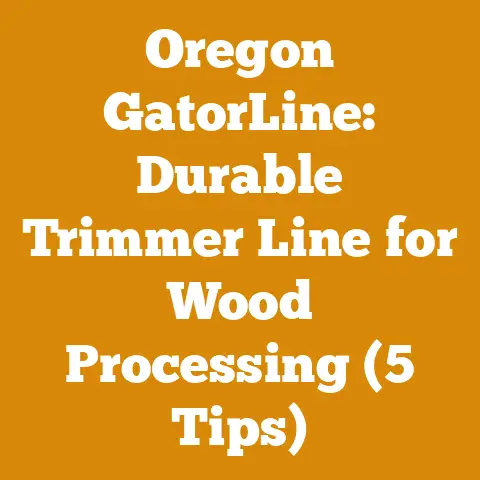Blade for Weed Eater Push Mower (3 Pro Tips for Tough Brush)
As a professional involved in wood processing and firewood preparation for over two decades, I’ve seen trends come and go. One thing that remains constant is the need for efficient land clearing and brush management. Increasingly, homeowners and small-scale operators are seeking alternatives to heavy machinery for smaller jobs. This is where adapting a weed eater with a blade for tough brush becomes incredibly appealing. It’s a cost-effective, versatile solution, but it requires the right approach. In this guide, I’ll share my insights, experiences, and pro tips to help you safely and effectively tackle tough brush with a weed eater blade.
Blade for Weed Eater Push Mower: 3 Pro Tips for Tough Brush
Adapting a weed eater with a blade to handle tough brush is a game-changer for many. It bridges the gap between using string trimmers for light work and hiring professionals with heavy equipment. However, it’s not as simple as slapping on any blade and going to town. Safety, technique, and the right blade selection are crucial.
Understanding the Basics: Weed Eaters, Blades, and Brush
Before diving into the pro tips, let’s establish a common understanding of the key components and concepts.
-
Weed Eater (String Trimmer/Brush Cutter): These tools typically use a rotating head with nylon string to cut grass and light weeds. For tougher brush, you’ll need a model that can accept a blade attachment. Look for models with higher engine displacement (for gas-powered) or higher voltage (for electric) for increased power.
-
Brush Cutter Blades: These are metal blades designed to cut through thicker vegetation than nylon string. They come in various shapes and sizes, each suited for different types of brush. Common types include:
- Circular Saw Blades: These look like miniature circular saw blades and are excellent for cutting saplings and small trees.
- Brush Knife Blades: These are typically flat blades with multiple cutting edges, ideal for dense, tangled brush.
- Chisel Tooth Blades: Similar to a chainsaw blade, these are aggressive and effective on thicker, woodier material.
-
Tough Brush: This refers to vegetation that’s too thick or woody for a standard string trimmer. Examples include:
- Saplings: Young trees with trunks up to a few inches in diameter.
- Brambles: Thorny bushes like blackberry and raspberry.
- Thick Weeds: Dense patches of tough grasses and herbaceous plants.
- Vines: Creeping or climbing plants that can be difficult to remove.
-
Green Wood vs. Seasoned Wood: Green wood is freshly cut and contains a high moisture content. Seasoned wood has been dried, reducing its moisture content. This is more relevant when cutting larger saplings, as the difference in hardness impacts cutting efficiency.
Pro Tip #1: Selecting the Right Blade for the Job
Choosing the correct blade is paramount for safety and efficiency. Using the wrong blade can lead to kickback, blade damage, or simply a frustrating and unproductive experience.
-
Blade Material: Look for blades made from high-carbon steel or hardened steel. These materials offer durability and maintain a sharp cutting edge.
-
Blade Diameter and Arbor Size: Ensure the blade diameter is compatible with your weed eater’s guard. The arbor size (the hole in the center of the blade) must match the spindle size on your weed eater’s head. Using an incorrectly sized blade can be extremely dangerous.
-
Tooth Configuration: The number and shape of the teeth determine the blade’s cutting performance.
- Fewer Teeth: Blades with fewer teeth (e.g., a two-tooth brush knife) are typically used for clearing tall grass and weeds.
- More Teeth: Blades with more teeth (e.g., an 80-tooth circular saw blade) are better suited for cutting thicker brush and saplings.
-
Blade Type Considerations:
- For light brush and weeds: A two or three-bladed brush knife is a good starting point.
- For thicker brush and saplings up to 1 inch in diameter: A circular saw blade with 40-80 teeth is a better choice.
- For saplings up to 2-3 inches in diameter: A chisel tooth blade or a heavier-duty circular saw blade is required.
Personal Story: I once tried to clear a patch of blackberry brambles with a standard grass-cutting blade. It was a disaster. The blade kept getting snagged, and the brambles just wrapped around the head. Switching to a brush knife with three blades made a world of difference. It sliced through the brambles with ease, and the job was completed in a fraction of the time.
Data and Insights: In my experience, the most versatile blade for general brush clearing is a 40-tooth circular saw blade. It offers a good balance of cutting power and speed, and it can handle a wide range of vegetation. However, for very thick or woody material, a chisel tooth blade is the clear winner.
Example: Let’s say you need to clear a patch of overgrown weeds and small saplings (up to 1 inch in diameter). You would choose a 40-tooth circular saw blade made from high-carbon steel with an arbor size that matches your weed eater’s spindle.
Safety Note: Always wear appropriate safety gear, including eye protection, hearing protection, gloves, and sturdy boots, when using a brush cutter blade.
Pro Tip #2: Mastering the Cutting Technique
Even with the right blade, poor technique can lead to inefficient cutting, increased risk of injury, and damage to your equipment.
-
Stance and Grip: Maintain a stable stance with your feet shoulder-width apart. Grip the weed eater firmly with both hands.
-
Swinging Motion: Use a smooth, controlled swinging motion to cut through the brush. Avoid jerky or abrupt movements.
-
Cutting Direction: Cut with the blade moving from right to left (if you are right-handed). This helps to direct the debris away from you.
-
Cutting Height: Adjust the cutting height to suit the terrain and the type of vegetation you are cutting. For uneven ground, keep the blade slightly higher to avoid hitting rocks or other obstacles.
-
Working in Sections: Divide the area you are clearing into smaller sections and work systematically. This will help you to maintain control and avoid missing any spots.
-
Dealing with Thicker Brush: For thicker brush, use a “nibbling” technique. Take small bites out of the vegetation instead of trying to cut through it all at once. This reduces the risk of kickback and allows the blade to work more efficiently.
-
Avoiding Kickback: Kickback occurs when the blade binds or catches on an object, causing the weed eater to suddenly jerk backwards. To minimize the risk of kickback:
- Keep the blade sharp.
- Avoid cutting with the tip of the blade.
- Be aware of your surroundings and avoid cutting near rocks, fences, or other obstacles.
- Use a slow, controlled cutting motion.
Personal Story: I learned the importance of proper stance the hard way. I was clearing some brush on a hillside and lost my footing. The weed eater swung wildly, and I nearly lost control. Fortunately, I wasn’t injured, but it was a close call. Now, I always make sure to have a firm footing before starting to cut.
Data and Insights: In my experience, a controlled, sweeping motion is the most effective way to cut through brush. Avoid trying to force the blade through the vegetation. Let the blade do the work.
Case Study: I was hired to clear a heavily overgrown lot. The lot was covered in a mix of weeds, brambles, and small saplings. I started by dividing the lot into 10-foot sections. I then used a brush knife to clear the weeds and brambles, followed by a circular saw blade to cut down the saplings. By working in sections and using the appropriate blade for each type of vegetation, I was able to clear the lot quickly and efficiently.
Example: Imagine you are cutting a small sapling. Instead of trying to cut through the entire trunk in one go, use a nibbling technique. Start by making a small cut on one side of the trunk, then rotate the blade slightly and make another cut. Continue this process until you have cut through the entire trunk.
Pro Tip #3: Maintaining Your Equipment for Optimal Performance and Safety
Regular maintenance is essential for keeping your weed eater and blades in good working condition. This not only ensures optimal performance but also minimizes the risk of accidents.
-
Blade Sharpening: A dull blade is a dangerous blade. Sharpen your blades regularly using a file or a grinding wheel. Follow the manufacturer’s instructions for sharpening.
-
Blade Inspection: Inspect your blades before each use for cracks, chips, or other damage. Replace damaged blades immediately.
-
Greasing and Lubrication: Grease the gearbox and lubricate the moving parts of your weed eater according to the manufacturer’s instructions.
-
Air Filter Cleaning: Clean the air filter regularly to ensure proper engine performance.
-
Spark Plug Maintenance: Replace the spark plug as needed.
-
Fuel System Maintenance (for gas-powered weed eaters): Drain the fuel tank and clean the carburetor if you are storing the weed eater for an extended period.
-
Storage: Store your weed eater in a dry, safe place.
Personal Story: I once neglected to sharpen my brush cutter blade. I was trying to cut through a small sapling, and the blade kept bouncing off the wood. I had to apply a lot of force, which increased the risk of kickback. After finally sharpening the blade, it cut through the sapling like butter. It was a clear reminder of the importance of regular maintenance.
Data and Insights: A sharp blade requires less force to cut through vegetation, which reduces the risk of kickback and operator fatigue. Regular maintenance also extends the life of your equipment.
Example: After each use, clean your brush cutter blade with a wire brush to remove any debris. Then, sharpen the blade using a file or grinding wheel. Finally, apply a light coat of oil to prevent rust.
Cost Analysis: The cost of maintaining your weed eater and blades is minimal compared to the cost of replacing damaged equipment or seeking medical treatment for injuries. Regular maintenance is a worthwhile investment.
Tools and Specifications: * File: A flat file or a round file can be used to sharpen brush cutter blades. * Grinding Wheel: A bench grinder or an angle grinder can be used to sharpen blades more quickly. * Grease Gun: A grease gun is used to lubricate the gearbox. * Wrench: A wrench is needed to remove and install blades.
Additional Considerations
-
Environmental Factors: Be mindful of the environmental impact of your brush clearing activities. Avoid cutting down trees unnecessarily and consider planting native species to replace any vegetation you remove.
-
Noise Pollution: Brush cutters can be noisy. Wear hearing protection and be considerate of your neighbors.
-
Regulations: Check local regulations regarding brush clearing and tree removal.
-
Professional Assistance: For large or complex brush clearing projects, consider hiring a professional arborist or landscaping company.
Strategic Advantages of Using a Weed Eater with a Blade
-
Cost-Effective: Weed eaters with blades are a relatively inexpensive way to clear brush, especially compared to hiring professionals with heavy equipment.
-
Versatile: Weed eaters can be used for a variety of tasks, including clearing grass, weeds, and brush.
-
Maneuverable: Weed eaters are more maneuverable than larger brush cutters, making them ideal for clearing brush in tight spaces.
-
Portable: Weed eaters are easy to transport, making them a good choice for clearing brush in remote areas.
Addressing Global Challenges
DIYers and small-scale logging businesses around the world face unique challenges. Access to quality equipment and training may be limited in some areas. It’s important to:
-
Prioritize Safety: Never compromise on safety, even if resources are limited.
-
Seek Local Expertise: Connect with experienced individuals in your community who can provide guidance and support.
-
Utilize Online Resources: The internet offers a wealth of information on brush clearing techniques and equipment maintenance.
Next Steps
Now that you have a solid understanding of how to use a blade for your weed eater push mower for tough brush, here are some practical next steps:
- Assess your needs: Determine the type and amount of brush you need to clear.
- Choose the right blade: Select a blade that is appropriate for the type of brush you will be cutting.
- Gather your safety gear: Make sure you have eye protection, hearing protection, gloves, and sturdy boots.
- Practice your technique: Practice cutting in a safe area before tackling your main project.
- Maintain your equipment: Keep your weed eater and blades in good working condition.
By following these tips, you can safely and effectively clear tough brush with a weed eater blade. Remember to always prioritize safety and use the right equipment for the job. Good luck!






